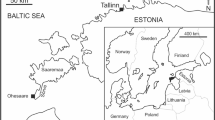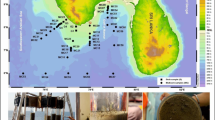Abstract
Considering the diversity and abundance of larger foraminifera examined from a wide range of Late Oligocene to Early Miocene palaeoenvironments in the Tethyan Seaway, encrusting bryozoans make extremely little use of their tests as substratum. Significant encrustations by bryozoans were exclusively found on large (ø c. 6 cm), undulating tests of Lepidocyclina spp., on which, however, a remarkable 34 taxa of encrusting bryozoans were recorded. This shallow-water fauna of Chattian age was analyzed in respect of the bryozoan taxa present, colony growth type, and mode of budding, colony size, as well as onset of reproduction. Taxic and morphological similarities between the fossil assemblage and modern faunas encrusting mobile substrata indicate a long history of bryozoans as part of the interstitial habitat, while the tests of certain larger foraminifera may have played a significant role in the evolution of shallow-water bryozoans by providing substrata for encrusting species in otherwise unfavorable environments.




Similar content being viewed by others
References
Aigner T (1983) Facies and origin of nummulitic buildups: an example from the Giza Pyramids plateau (Middle Eocene, Egypt). N Jb Geol Paläontol Abh 166:347–368
Bassi D (2005) Larger foraminiferal and coralline algal facies in an Upper Eocene, storm-influenced, shallow water carbonate platform (Colli Berici, north-eastern Italy). Palaeogeogr Palaeoclimatol Palaeoecol 226:17–35. doi:10.1016/j.palaeo.2005.05.002
Beavington-Penney SJ, Racey A (2004) Ecology of extant nummulitids and other larger benthic foraminifera: applications in palaeoenvironmental analysis. Earth Sci Rev 67:219–265. doi:10.1016/j.earscirev.2004.02.005
Beavington-Penney SJ, Wright VP, Racey A (2005) Sediment production and dispersal on foraminifera-dominated early Tertiary ramps: the Eocene El Garia Formation, Tunisia. Sedimentology 52:527–569. doi:10.1111/j.1365-3091.2005.00709.x
Berning B (2006) The cheilostome bryozoan fauna from the late Miocene of Niebla (Guadalquivir Basin, SW Spain): environmental and biogeographic implications. Mitt Geol-Paläontol Inst Univ Hamburg 90:7–156
Berning B, Tilbrook KJ, Rosso A (2008) Revision of the north-eastern Atlantic and Mediterranean species of the genera Herentia and Therenia (Bryozoa: Cheilostomata). J Nat Hist 42:1509–1547. doi:10.1080/00222930802109140
Bishop JDD (1988) Disarticulated bivalve shells as substrates for encrustation by the bryozoan Cribrilina puncturata in the Plio-Pleistocene Red Crag of eastern England. Palaeontology 31:237–253
Bishop JDD (1989) Colony form and the exploitation of spatial refuges by encrusting Bryozoa. Biol Rev Camb Philos Soc 64:197–218. doi:10.1111/j.1469-185X.1989.tb00675.x
Bishop JDD (1994) Survival and reproductive output in relation to substrate type in a bryozoan encrusting disarticulated bivalve shells. In: Hayward PJ, Ryland JS, Taylor PD (eds) Biology and palaeobiology of bryozoans. Olsen & Olsen, Fredensborg, pp 23–28
Braga G, Bahr SA (2003) Bryozoa from the Oligocene succession of Jabal Hafit, Al Ain, United Arab Emirates and Arabian Peninsula. Boll Soc Paleontol Ital 42:241–265
Brett CE (1990) Obrution deposits. In: Briggs DEG, Crowther PR (eds) Paleobiology: a synthesis. Blackwell Science, Oxford, pp 239–243
Buss LW (1979) Habitat selection, directional growth and spatial refuges: why colonial animals have more hiding places. In: Larwood GP, Rosen BR (eds) Biology and systematics of colonial organisms. Academic Press, London, pp 459–497
Cheetham AH (1963) Late Eocene zoogeography of the eastern Gulf Coast region. Geol Soc Am 91:1–113
Choi DR, Ginsburg RN (1983) Distribution of coelobites (cavity-dwellers) in coral rubble across the Florida Reef Tract. Coral Reefs 2:165–172. doi:10.1007/BF00336723
Cook PL (1967) Polyzoa (Bryozoa) from West Africa. The Pseudostega, the Cribrimorpha and some Ascophora imperfecta. Bull British Mus (Nat Hist) Zool 15:321–351
Cook PL (1968a) Bryozoa (Polyzoa) from the coast of tropical West Africa. Atlantide Rep 10:115–262
Cook PL (1968b) Polyzoa from West Africa. The Malacostega. Part I. Bull British Mus (Nat Hist) Zool 16:115–160
Cook PL (1985) Bryozoa from Ghana, a preliminary survey. Koninkl Mus Midden-Afrika (Tervuren, België). Zool Wetensch - Ann 238:1–315
Cuffey RJ (1973) Bryozoan distribution in the modern reefs of Eniwetok Atoll and the Bermuda platform. Pac Geol 6:25–50
Drooger CW (1993) Radial foraminifera: morphometrics and evolution. Verh Koninkl Nederlandse Akad Wetensch, Afd Natuurk Eerste Reeks 41:1–242
Furon R, Balavoine P (1959) Les bryozoaires aquitaniens de Qoum (Iran). Bull Soc Geol Fr 7:294–303
Hageman SA, Kaesler RL, Broadhead TW (2004) Fusulinid taphonomy: encrustation, corrasion, compaction, and dissolution. Palaios 19:610–617. doi:10.1669/0883-1351(2004)019<0610:FTECCA>2.0.CO;2
Håkansson E, Winston JE (1985) Interstitial bryozoans: unexpected life forms in a high energy environment. In: Nielsen C, Larwood GP (eds) Bryozoa: Ordovician to Recent. Olsen & Olsen, Fredensborg, pp 125–134
Hallock P (1999) Symbiont-bearing foraminifera. In: Sen Gupta BK (ed) Modern foraminifera. Kluwer Press, Amsterdam, pp 123–139
Hallock P, Glenn EC (1986) Larger foraminifera: a tool for paleoenvironmental analysis of Cenozoic carbonate depositional facies. Palaios 1:44–64
Harmelin J-G (1977) Bryozoaires des Îles d’Hyères: cryptofaune bryozoologique des valves de Pinna nobilis rencontrées dans les herbiers de Posidonies. Trav Sci Parc Nat Port-Cros 3:143–157
Harmelin J-G (1984) Bryozoaires des peuplements sciaphiles de Méditerranée: révision de Cribrilina setosa Waters et description de deux nouvelles espèces de Cribrilaria (Bryozoa, Cheilostomata). Zool Scr 13:81–88. doi:10.1111/j.1463-6409.1984.tb00025.x
Harmelin J-G (1986) Patterns in the distribution of bryozoans in the Mediterranean marine caves. Stygologia 2:10–25
Harmelin J-G (1988) Espèces affines microsympatriques chez Puellina (Bryozoa, Cheilostomata) et description d’espèces nouvelles. Zool Scr 17:25–38. doi:10.1111/j.1463-6409.1988.tb00084.x
Harmelin J-G, Arístegui J (1988) New Cribrilinidae (Bryozoa, Cheilostomata) from the upper bathyal of the Atlanto-Mediterranean region. J Nat Hist 22:507–535. doi:10.1080/00222938800770351
Harmelin J-G, Boronat J, Moissette P, Rosso A (1989) Distansescharella seguenzai Cipolla, 1921 (Bryozoa, Cheilostomata), nouvelles données morphologiques et écologiques tirées de spécimens fossiles (Miocène, Pliocène) et actuels de Méditerranée. Geobios 22:485–501. doi:10.1016/S0016-6995(89)80100-7
Harzhauser M, Kroh A, Mandic O, Piller WE, Göhlich U, Reuter M, Berning B (2007) Biogeographic responses to geodynamics: a key study all around the Oligo-Miocene Tethyan Seaway. Zool Anz 246:241–256. doi:10.1016/j.jcz.2007.05.001
Hayward PJ, Ryland JS (1998) Cheilostomatous Bryozoa. Part 1. Aeteoidea—Cribrilinoidea. Synopses of the British fauna. Field Studies Council, Shrewsbury
Hayward PJ, Ryland JS (1999) Cheilostomatous Bryozoa. Part 2. Hippothooidea—Celleporoidea. Synopses of the British fauna. Field Studies Council, Shrewsbury
Jackson JBC (1979) Morphological strategies of sessile animals. In: Larwood GP, Rosen B (eds) Biology and systematics of colonial organisms. Academic Press, London, pp 499–555
Jackson JBC (1984) Ecology of cryptic coral reef communities. III. Abundance and aggregation of encrusting organisms with particular reference to cheilostome Bryozoa. J Exp Mar Biol Ecol 75:37–57. doi:10.1016/0022-0981(84)90022-4
Jackson JBC, Winston JE (1982) Ecology of cryptic coral reef communities. I. Distribution and abundance of major groups of encrusting organisms. J Exp Mar Biol Ecol 57:135–147. doi:10.1016/0022-0981(82)90188-5
Kobluk DR, Cuffey RJ, Fonda SS, Lysenko MA (1988) Cryptic Bryozoa, leeward fringing reef of Bonaire, Netherlands Antilles, and their paleoecological application. J Paleontol 62:427–439
Lidgard S (1985) Zooid and colony growth in encrusting cheilostome bryozoans. Palaeontology 28:255–291
Matteucci R, Pignatti JS (1988) The taphonomy of Nummulites. 4th Symposium of Benthic Ecology and Paleoecology. Museo Regionale di Scienze Naturali, Torino, pp 183–198
McKinney FK (1992) Competitive interactions between relates clades: evolutionary implications of overgrowth interactions between encrusting cyclostome and cheilostome bryozoans. Mar Biol (Berl) 114:645–652. doi:10.1007/BF00357261
McKinney FK (2000) Colony sizes and occurrence patterns among Bryozoa encrusting disarticulated bivalves in the northeastern Adriatic Sea. In: Herrera Cubilla A, Jackson JBC (eds) Proceedings of the 11th International Bryozoology Association Conference. Smithsonian Tropical Research Institute, Balboa, Republic of Panama, Panama City, pp 282–290
McKinney FK, Jackson JBC (1989) Bryozoan evolution. Unwin Hyman, Boston
McKinney FK, Taylor PD (1997) Life histories of some Mesozoic encrusting cyclostome bryozoans. Palaeontology 40:515–556
Meesters E, Knijn R, Willemsen P, Pennartz R, Roebers G, van Soest RWM (1991) Sub-rubble communities of Curaçao and Bonaire coral reefs. Coral Reefs 10:189–197. doi:10.1007/BF00336773
Nørvang A (1961) Schizamminidae, a new family of foraminifera. Atlantide Rep 6:169–201
Okamura B, Harmelin J-G, Jackson JBC (2001) Refuges revisited: enemies versus flow and feeding as determinants of sessile animal distribution and form. In: Jackson JBC, Lidgard S, McKinney FK (eds) Evolutionary patterns: growth, form, and tempo in the fossil record. The University of Chicago Press, Chicago, pp 61–93
Reguant S, Mayoral E (1994) The encrusting Bryozoa on disarticulated bivalve shells (chiefly of Glycymeris insubrica) in the Lower Pliocene of Huelva (SW Spain). In: Hayward PJ, Ryland JS, Taylor PD (eds) Biology and palaeobiology of bryozoans. Olsen & Olsen, Fredensborg, pp 157–160
Reuter M, Piller WE, Harzhauser M, Mandic O, Berning B, Rögl F, Kroh A, Aubry M-P, Wielandt-Schuster U, Hamedani A (2008) The Oligo-/Miocene Qom Formation (Iran)—evidence for an early Burdigalian restriction of the Tethyan Seaway and closure of its Iranian gateways. Int J Earth Sci. doi:10.1007/s00531-007-0269-9
Rögl F (1998) Palaeogeographic considerations for Mediterranean and Paratethys Seaways (Oligocene to Miocene). Ann Naturhist Mus Wien (Ser. A) 99:279–310
Schuster F, Wielandt U (1999) Oligocene and Early Miocene coral faunas from Iran: palaeoecology and palaeobiogeography. Int J Earth Sci 88:571–581. doi:10.1007/s005310050285
Smith AM (1995) Palaeoenvironmental interpretation using bryozoans: a review. In: Bosence DWJ, Allison PA (eds) Marine palaeoenvironmental analysis from fossils. Geol Soc Spec Pub 83:231–243
Taylor PD (1999) Bryozoans. In: Savazzi E (ed) Functional morphology of the invertebrate skeleton. Wiley, Chichester, pp 623–646
Tilbrook KJ (2006) Cheilostomatous Bryozoa from the Solomon Islands. Santa Barbara Mus Nat Hist Monogr 4:1–385
Van der Zwaan GJ, Duijnstee IAP, den Dulk M, Ernst SR, Jannink NT, Kouwenhoven TJ (1999) Benthic foraminifers: proxies or problems? Earth Sci Rev 46:213–236. doi:10.1016/S0012-8252(99)00011-2
Ward MA, Thorpe JP (1989) Assessment of space utilisation in a subtidal temperate bryozoan community. Mar Biol (Berl) 103:215–224. doi:10.1007/BF00543350
Wilson MEJ, Lokier SW (2002) Siliciclastic and volcaniclastic influences on equatorial carbonates: insights from the Neogene of Indonesia. Sedimentology 49:583–601. doi:10.1046/j.1365-3091.2002.00463.x
Winston JE (1985) Life history studies of Disporella and Drepanophora in Jamaica. In: Nielsen C, Larwood GP (eds) Bryozoa: Ordovician to Recent. Olsen & Olsen, Fredensborg, p 350
Winston JE, Jackson JBC (1984) Ecology of cryptic coral reef communities. IV. Community development and life histories of encrusting cheilostome Bryozoa. J Exp Mar Biol Ecol 76:1–21. doi:10.1016/0022-0981(84)90013-3
Winston JE, Håkansson E (1986) The interstitial bryozoan fauna from Capron Shoals, Florida. American Mus Nov 2865:1–50
Winston JE, Migotto AE (2005) A new encrusting interstitial marine fauna from Brazil. Invertebr Biol 124:79–87
Yordanova EK, Hohenegger J (2002) Taphonomy of larger foraminifera: relationships between living individuals and empty tests on flat reef slopes (Sesoko Island, Japan). Facies 46:169–203. doi:10.1007/BF02668080
Acknowledgments
The larger foraminifera were determined by Ulrike Wielandt-Schuster (Landesamt für Geologie, Freiburg). We thank Willem Renema (Naturalis, Leiden) and Elza Yordanova (Universität Wien) for discussions on larger foraminifera, and Davide Bassi as well as two anonymous reviewers for constructive criticism on the manuscript. This work was supported by the Austrian Fonds zur Förderung der wissenschaftlichen Forschung (FWF: P11886-GEO, P18189) and the Deutsche Forschungsgemeinschaft (DFG: STE 857/1-1; NE 537/1-1, -2).
Author information
Authors and Affiliations
Corresponding author
Rights and permissions
About this article
Cite this article
Berning, B., Reuter, M., Piller, W.E. et al. Larger foraminifera as a substratum for encrusting bryozoans (Late Oligocene, Tethyan Seaway, Iran). Facies 55, 227–241 (2009). https://doi.org/10.1007/s10347-008-0169-x
Received:
Accepted:
Published:
Issue Date:
DOI: https://doi.org/10.1007/s10347-008-0169-x




